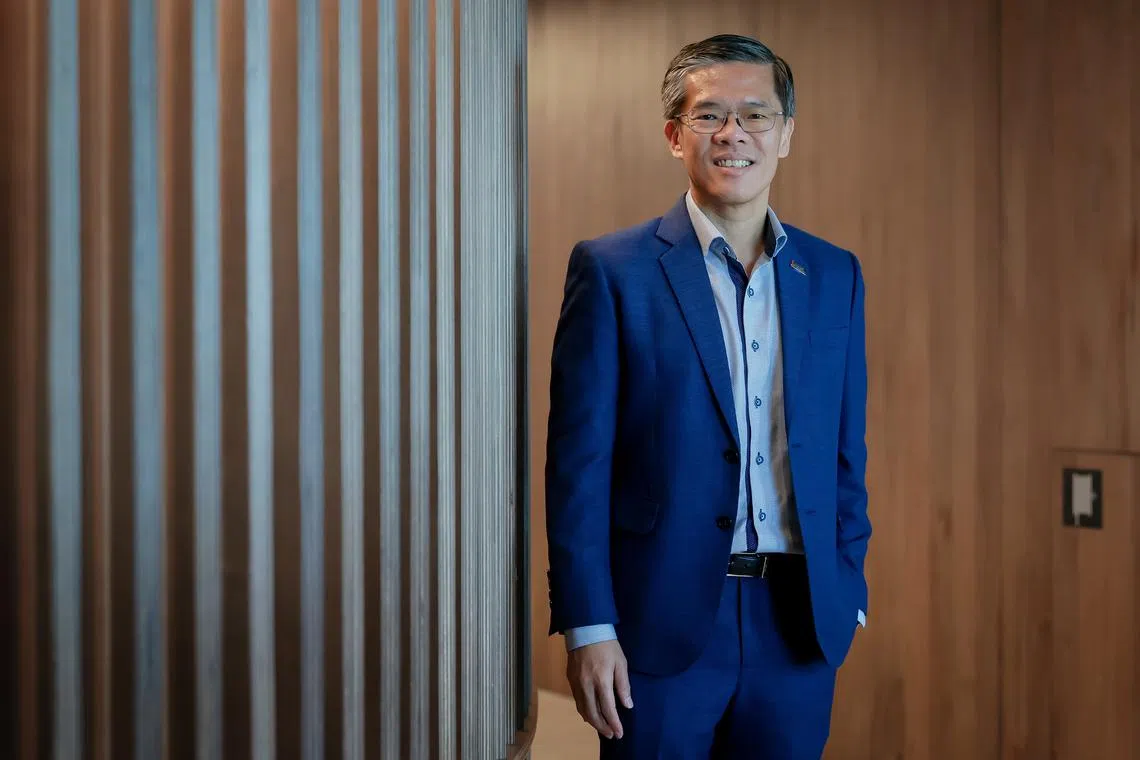Asean can fend off protectionism blow by boosting integration: Singapore Business Federation chief
Sign up now: Get ST's newsletters delivered to your inbox

Singapore Business Federation chief executive Kok Ping Soon said the opportunity for collective action by Asean has never been greater.
ST PHOTO: GAVIN FOO
Follow topic:
SINGAPORE - Asean, the world’s fourth-largest economy, does not have to take US President Donald Trump’s tariff-induced chaos lying down.
The regional grouping’s members can instead close ranks and accelerate progress towards a long-stated goal of economic integration – which would boost intra-regional flow of goods, services and investments, and create new jobs.
An Asean that is a more homogenised market can then become a global production base, with strong trade and investment links with other major economies worldwide.
This would be Asean’s desired response, said Mr Kok Ping Soon, chief executive of the Singapore Business Federation (SBF), the Republic’s apex business association with more than 32,000 companies under its fold.
It would not only enable the grouping’s members to mitigate any medium-term loss in economic growth, trade and investment, but also further strengthen the region’s economy.
Mr Kok said Asean can boost economic integration by removing non-tariff barriers to trade, leveraging its fast-growing digital and green economy, and intensifying its trade and investment engagements with other trading blocs.
“I think the question is whether, in the current climate, we are able to do more to strengthen Asean’s economic integration. The answer must be absolutely yes. If not now, then when? The impetus (now) is even stronger,” Mr Kok told The Straits Times in an interview.
Asean is a grouping of diverse economies, with some highly exposed to global trade and others mainly dependent on natural resources and labour-intensive industries.
But, put together, Asean in 2024 had an estimated gross domestic product of US$4.13 trillion (S$5.31 trillion), accounting for 8 per cent of global trade and 5 per cent of manufacturing value-added; and in 2023 it attracted 17 per cent of foreign direct investment, according to the Economic Research Institute for Asean and East Asia.
The 10-member regional bloc has become China’s top trading partner, Japan’s second-largest, the European Union’s and South Korea’s third-largest, and the fourth-largest for the United States.
Asean’s diversity is part of its appeal, as it offers investment opportunities at various stages of the value chain and allows trade in a wide assortment of goods and services.
But when it comes to intra-regional trade, the disparity between the economies becomes a source of inertia.
Trade within Asean has been stagnant in the past decade at about 22 per cent of the region’s total. That compares with 62 per cent for the EU and about 40 per cent for the US-Mexico-Canada Agreement members.
This is because while the bloc has over the years successfully eliminated most levies that are paid at the border, non-tariff barriers remain a hindrance.
In 2019, the EU-Asean Business Council estimated that there are about 6,000 non-tariff measures across the region – with many being potential barriers to trade. And this number continues to grow.
Hinrich Foundation, a Singapore-based think-tank, found that Asean economies between 2015 and 2025 put in place 9,873 non-tariff measures that have undercut regional value chains and created obstacles to regional trade in a host of products.
Mr Kok noted that licensing bottlenecks, inconsistent standards and customs procedures that require excessive documentation continue to weigh down intra-regional trade.
He said pacts such as the Asean Trade in Goods Agreement – which is part of the Asean Economic Community Blueprint 2025 – can help, but not before they are ratified by member states.
“We really need to make a greater effort to remove some of these non-tariff barriers,” Mr Kok said.
The same is true for the Asean Digital Economy Framework Agreement (Defa), which holds the key to unlocking the region’s true potential in trading digital services.
“A lot of attention is focused on trade in goods, because of the US tariffs,” the CEO of SBF said.
“But it is the trade in services that is more exciting and multifold and for that, what businesses are looking for is the free flow of data, digital payments and digital identity,” he added.
Asean has already risen to become the world’s third-largest digital services exporter, behind only the US and Britain. The World Economic Forum estimates that Asean’s digital economy is on track to hit US$600 billion in gross merchandise value by 2030.
Mr Kok said Defa can help Asean economies claim an even larger share of global digital services exports and reinvigorate the region’s start-up ecosystems.
The region is already home to some of the fastest-growing unicorns.
These include Singapore’s Grab, Sea Group and Lazada; Indonesia’s GoTo, Bukalapak and Traveloka; Thailand’s Ascend Money; Vietnam’s VNG messaging app Zalo; and Malaysia’s car marketplace Carsome.
But to boost the competitive advantage of existing and upcoming unicorns and digital services exporters, Asean will have to address the regulatory fragmentation and non-tariff barriers, and push for interoperability of digital identities.
Mr Kok said companies are looking for consistent standards for cross-border data flow, and digital payments as well.
In 1998, the World Trade Organisation declared a moratorium on customs duties related to e-commerce transactions. That moratorium is set to expire in 2026.
Trade experts fear that expiry of the moratorium would send a wave of protectionist measures worldwide, undermining Asean’s digital value chains by increasing the costs of doing business. Hence, a speedy conclusion and ratification of Defa by Asean members becomes even more critical.
Related to digitalisation is also the transition to a green economy, which includes carbon trading and the Asean power grid for renewable energy transmission.
Mr Kok said that with the world economy fragmenting amid geopolitical and trade conflicts, the urgency and opportunity for collective action have never been greater.
“There is opportunity… but whether we can live up to it is a big question,” he added.


